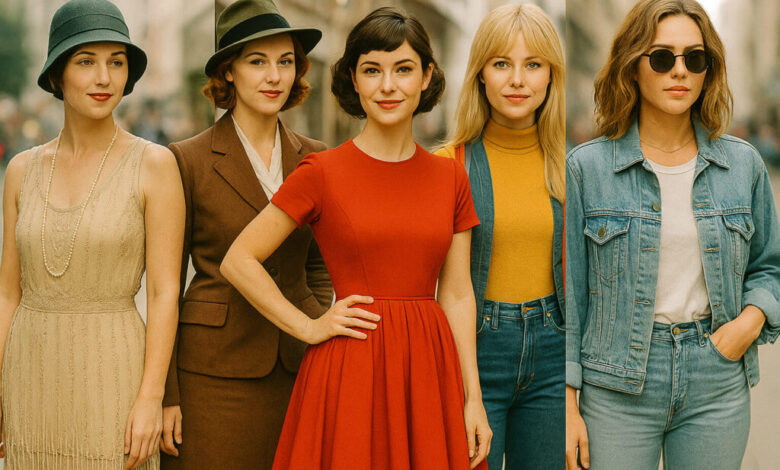The Ever-Evolving World of Fashion: A Deep Look Into Style, Culture, and Creativity

Fashion is more than just clothing—it is a language, a form of self-expression, and a powerful cultural force that has shaped societies for centuries. From ancient civilizations to modern global runways, fashion has continually evolved to reflect the values, identities, and lifestyles of people around the world. Today, fashion stands at the intersection of creativity, technology, sustainability, and global influence, making it one of the most dynamic fields in the world. This article explores how fashion has transformed over time, why it matters, and what the future of style may look like.
A Brief History of Fashion and Its Cultural Roots
Fashion has existed since the beginning of human civilization, although its purpose has changed dramatically through the years. In ancient times, clothing served mainly as protection from weather and environment. Materials like animal skins, natural fibers, and handmade fabrics were used based on climate and lifestyle. But even in early societies, clothing began to signal status, power, and identity.
In ancient Egypt, for example, linen garments signified cleanliness and wealth. Jewelry was worn not only for decoration but also for spiritual protection. In Greece and Rome, draped garments such as togas symbolized social class and citizenship. As time went on, clothing became more elaborate, especially among royalty. Kings and queens wore richly embroidered garments and luxurious materials like silk and velvet, which were rare and expensive.
The Middle Ages saw fashion becoming deeply influenced by religion and social hierarchy. Nobles wore heavy fabrics and bright colors, while peasants used simple, rough fabrics. By the Renaissance, fashion took a more artistic turn, with elegant tailoring, lace, and embroidery reflecting the era’s love of beauty and innovation.
By the 20th century, fashion changed rapidly with industrialization, global trade, and new technologies. Designers such as Coco Chanel, Christian Dior, and Yves Saint Laurent transformed clothing into an art form. Clothing ceased to be only functional—it became a statement.
Fashion as a Form of Self-Expression
One of the most powerful aspects of fashion is its ability to express individuality. Clothing communicates personality, taste, and even mood. A bold, colorful outfit might reflect confidence, while minimalistic clothing can signal simplicity and elegance. Streetwear expresses youth culture and creativity, while formal fashion represents professionalism and sophistication.
Today, people have endless ways to express themselves. Trends are no longer dictated only by high-end designers; social media, influencers, and everyday individuals inspire new ideas and styles around the world. Fashion has become democratic—anyone can participate, create, and influence.
The Globalization of Fashion
Thanks to technology and the internet, fashion trends now travel faster than ever before. In the past, a style introduced on a runway might take months to reach stores. Today, trends spread instantly through platforms like Instagram, TikTok, and Pinterest. A single viral video can turn a simple outfit into a worldwide trend in just days.
Globalization has also allowed cultures to blend and influence one another. Japanese street fashion, African prints, Indian embroidery, and Korean pop-inspired styles have all gained global popularity. This cultural exchange creates rich and diverse fashion trends that celebrate heritage while appealing to international audiences.
The Business Side of Fashion
Fashion is not only creative—it is a massive global industry worth trillions of dollars. It includes designers, manufacturers, models, influencers, photographers, marketers, and retailers. Fashion shows and weeks in cities like Paris, Milan, London, and New York highlight some of the most innovative work in the industry.
Fast fashion brands have made clothing more affordable and accessible, but they also raise concerns about environmental impact and labor conditions. On the other hand, luxury brands focus on craftsmanship, heritage, and exclusivity. Both segments play major roles in shaping consumer behavior.
Online shopping has revolutionized the industry as well. E-commerce platforms allow people to browse and purchase items from anywhere in the world. Personalized recommendations, virtual try-on tools, and quick delivery have changed the way people shop forever.
Sustainability: The Future of Fashion
In recent years, sustainability has become one of the most important topics in fashion. The industry has faced criticism for contributing to pollution, textile waste, and unethical labor practices. This has led to a growing demand for eco-friendly fashion.
Many brands now use recycled materials, organic fabrics, and ethical production methods. Concepts like slow fashion encourage consumers to buy fewer but higher-quality items. Thrift shopping and upcycling—turning old clothes into new designs—have also gained popularity, especially among younger generations who are passionate about saving the planet.
Digital fashion, where people purchase virtual clothing for online avatars or social media content, is another emerging trend that reduces waste while offering unlimited creativity.
Technology’s Impact on Fashion
Technology has transformed fashion in ways once thought impossible. Designers now use 3D printing to create unique garments and accessories. Artificial Intelligence helps predict trends, personalize shopping experiences, and improve supply chains. Augmented Reality (AR) allows shoppers to virtually try on clothes using their smartphone cameras.
Wearable technology, such as smartwatches and fitness trackers, combines fashion with function. Some designers even create clothing that can change color or adjust temperature based on the environment. Technology is pushing fashion beyond fabric and stitching into an entirely new era of innovation.
The Role of Social Media and Influencers
Social media has become one of the most powerful drivers of fashion trends. Influencers, bloggers, and celebrities shape what millions of people wear. A simple post from a popular influencer can increase demand for a product instantly.
Platforms like TikTok have created micro-trends—short-lived but highly popular styles that rise and fall quickly. Trends such as “soft girl,” “streetwear aesthetic,” “Y2K fashion,” and “minimalist chic” spread rapidly, especially among young people. Fashion is no longer just top-down; it’s a conversation between brands and consumers.
Why Fashion Matters
Fashion matters because it is deeply connected to identity, culture, economy, and art. It reflects who we are, what we value, and how we see the world. It can bring confidence, inspire creativity, and create jobs for millions. Fashion celebrates diversity by allowing people of different backgrounds, sizes, and cultures to express themselves freely.
Conclusion: A World of Endless Possibilities
Fashion will continue to evolve, influenced by technology, sustainability, culture, and creativity. Its future is bright, dynamic, and full of possibilities. Whether it’s haute couture on runways, street fashion in everyday life, or digital clothing in virtual worlds, fashion remains a universal form of expression that connects people across the globe.




